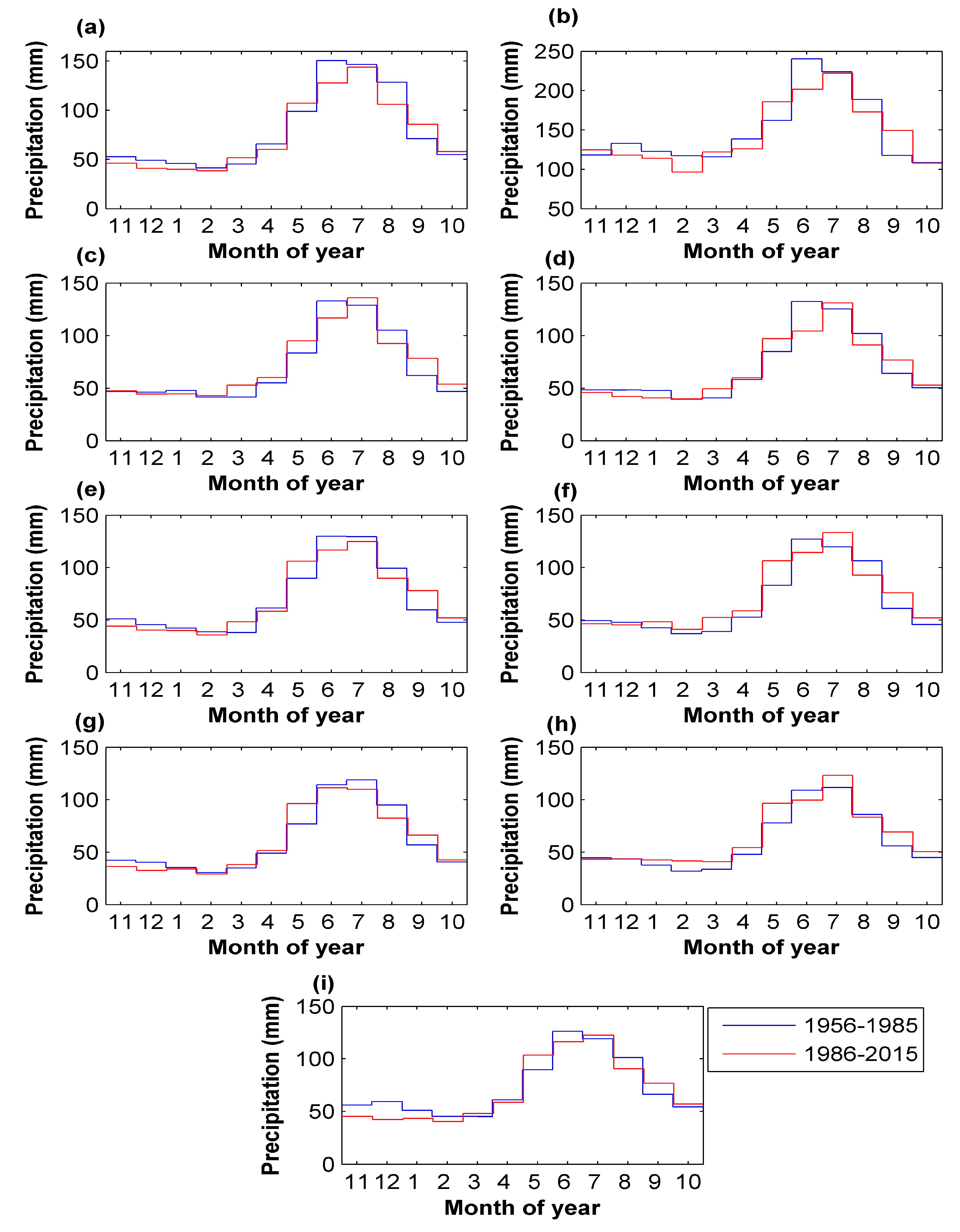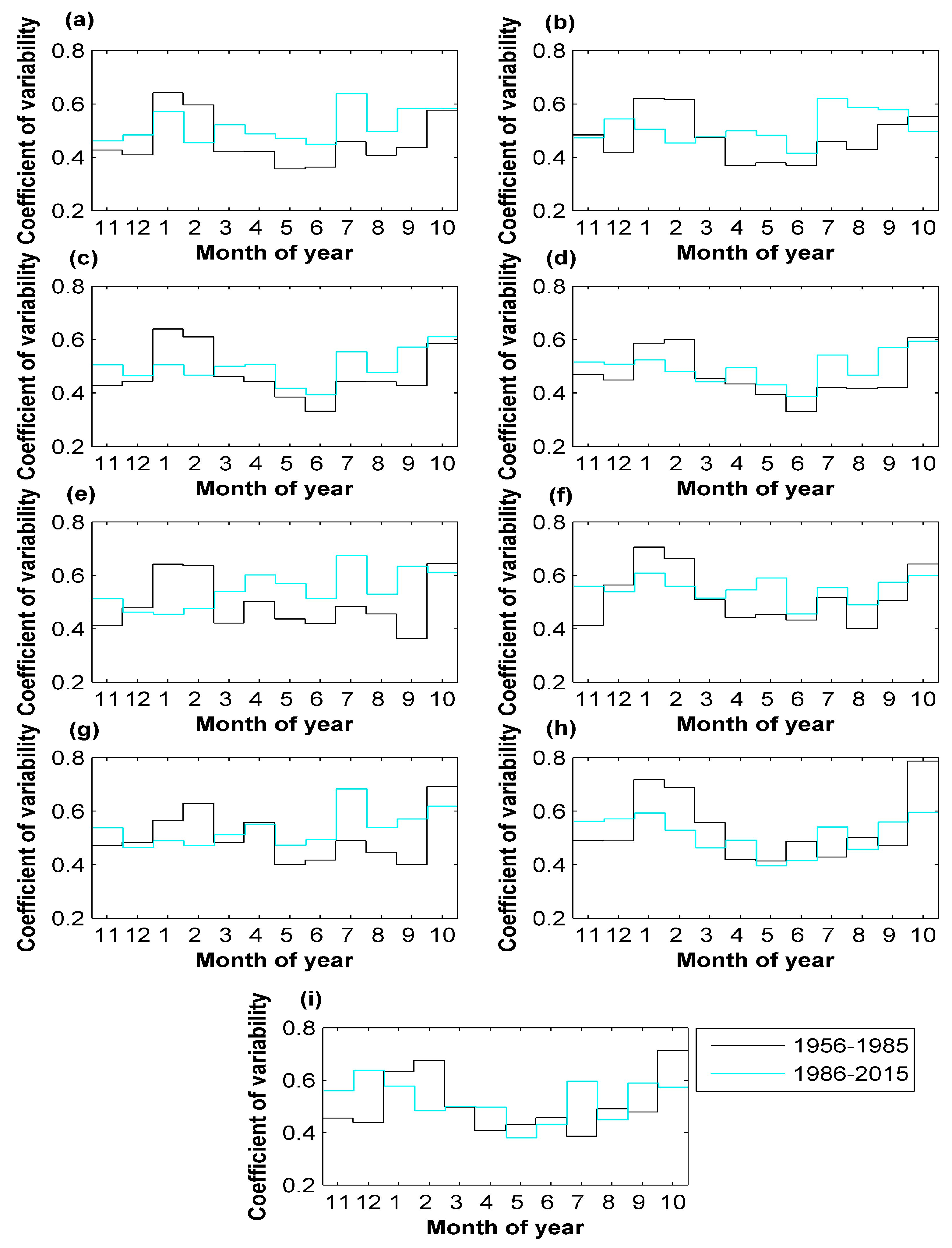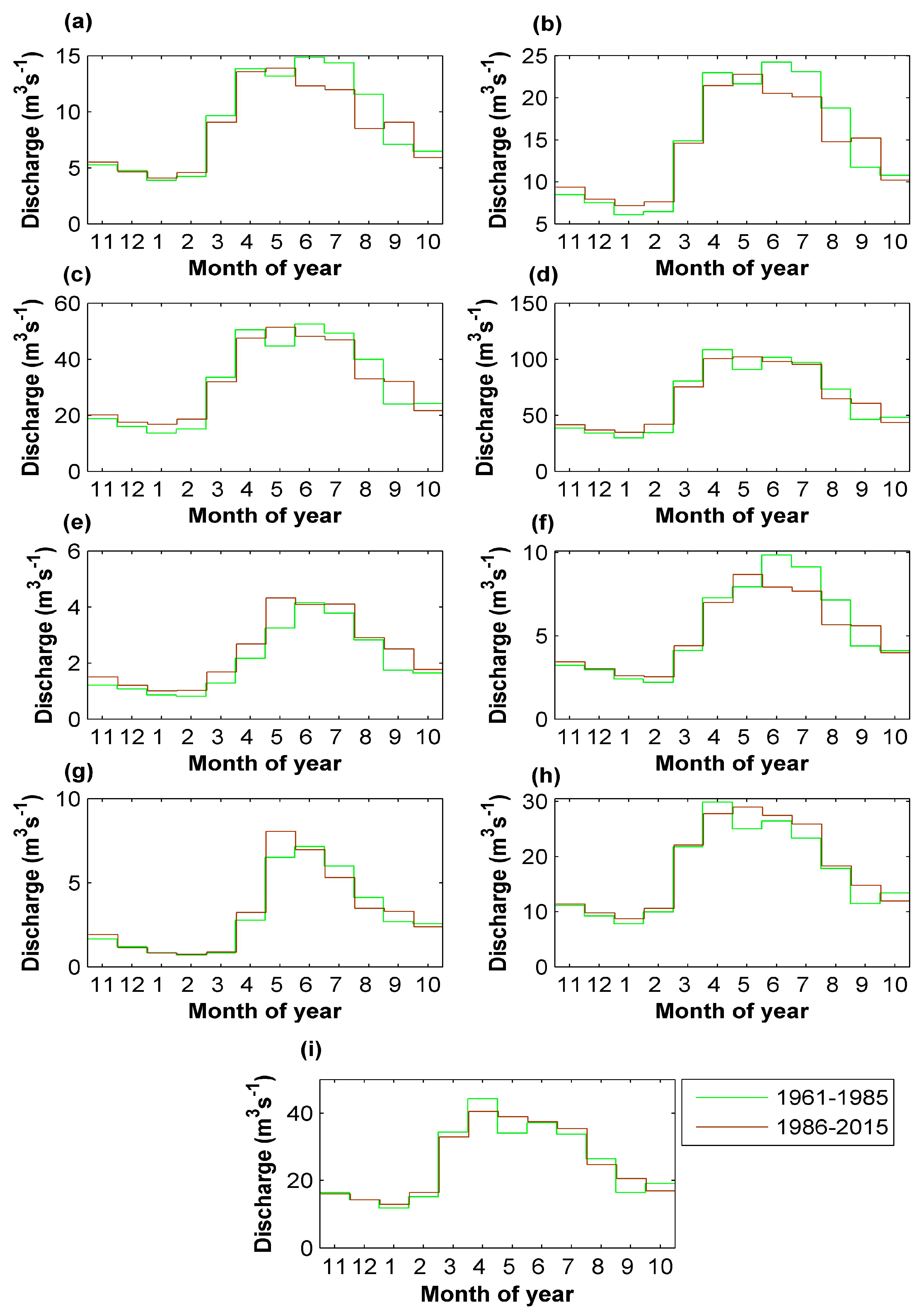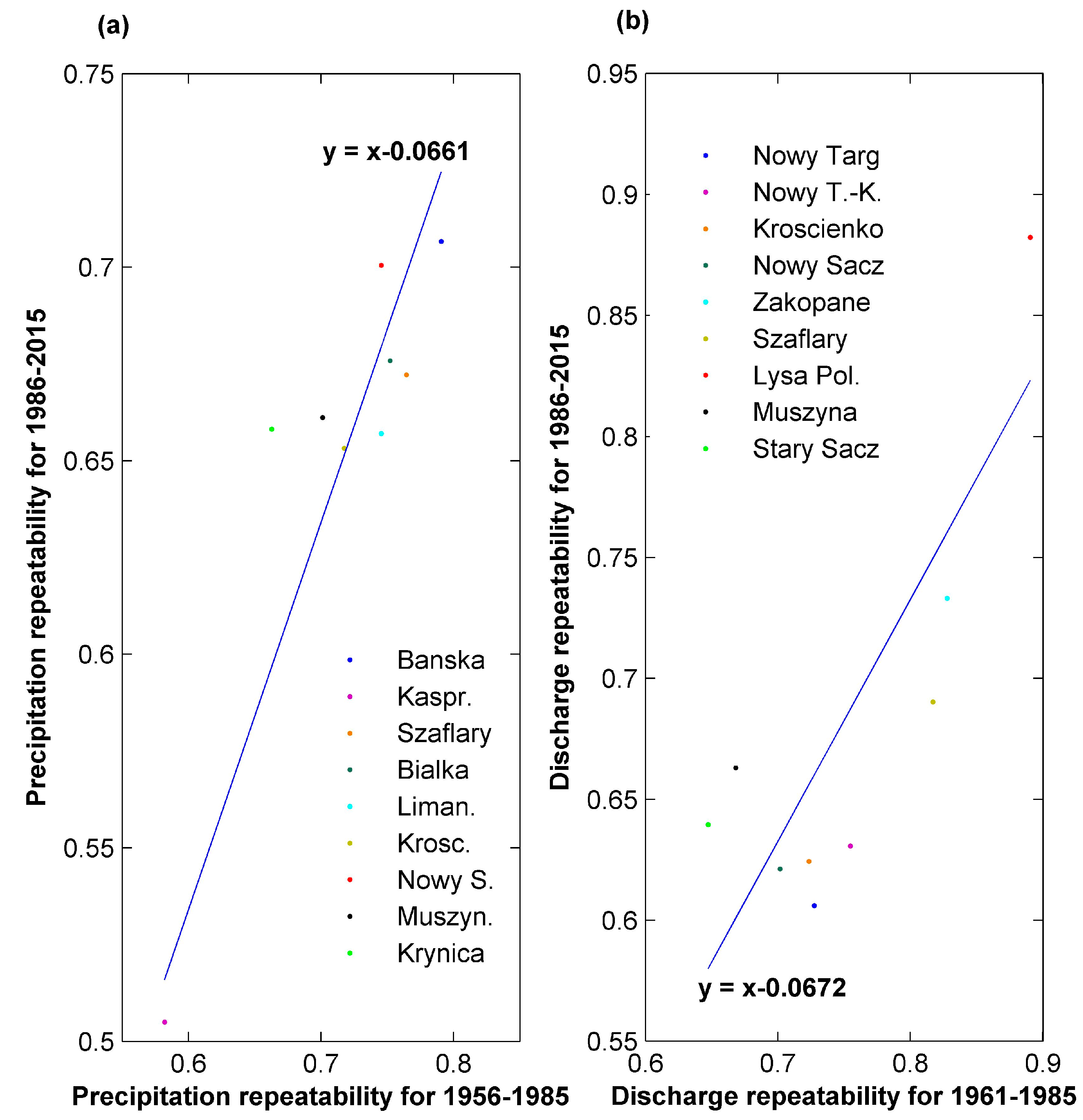1. Introduction
The circulation of water in a climate system is crucial to life on land. Changes in the water cycle associated with a global warming trend in air temperature are, therefore, of great importance worldwide. Natural climate variability across a wide range of timescales, with complex, nonlinear interactions within the climate system, including positive and negative feedbacks [
1] (pp. 121, 127), implies that even crucial changes in the climate may, at first, occur sporadically and therefore will likely be statistically insignificant. This is particularly true of precipitation due to its large variability and intermittent character [
2]. On the other hand, good management of water resources should be based on reliable information about predicted changes in water cycle on the basis of the changes already observed [
3].
In this context, studies focusing on in situ observations that document changes in hydro-climatic variability in mountain regions seem to be particularly important. Typically, mountains with orographic precipitation and accumulated snow pack are crucial water source regions. Significant changes in the water cycle in such regions can produce far-reaching consequences for accessible water resources and freshwater availability or scarcity at a much larger scale, especially for lowland areas, therefore, informed decisions made on the basis of observed changes are vital for better water resources management and planning. In general, with higher temperatures in the wintertime, more precipitation occurs in the form of rain instead of snow. According to Trenberth and Asrar [
2], higher temperatures in the wintertime over continents are expected to favor higher snowfall, while snow pack will melt quicker and sooner, resulting in a reduced amount of snow pack in the spring. Consequently, earlier run-off and changes in peak river flow are anticipated [
2].
Complex topography and the resulting distribution of precipitation in mountain regions present an additional difficulty in quantifying changes in the water cycle. A review of climate change in the European Alps [
4] shows that the observed warming trend in air temperature has strengthened since 1980, but changes in precipitation have been inhomogeneous, and largely dependent on the region, season, and time period studied. Moreover, recent changes in the frequency of heavy precipitation and floods in the Alpine-region do not go beyond large natural climate variability [
4]. However, on the basis of regional climate simulations at a spatial resolution of 25 km, projected 21st century changes (2070–2099 versus 1970–1999) in Alpine precipitation include a decrease in the frequency of wet days in the summer accompanied by an increase in mean precipitation in the winter [
5]. Concerning the Carpathian region, with its highest range (Tatra Mountains), the identified significant trend in annual mean surface temperature representing the entire area was found to be increasing, with a rate of change of 0.27 °C per decade (1961–2010); and for the period since 1981, a higher warming rate of 0.51 per decade has been identified [
6]. Wind speed was found to decrease in every season, while relative sunshine duration increased. At the same time (1961–2010), Carpathian area precipitation shows no trends in annual and seasonal totals [
6].
It seems, therefore, desirable to conduct more detailed analyses of precipitation patterns and their variability in mountain areas in order to gain insight into different aspects of potential hydrologic change at smaller, sub-regional, and local scales. For this reason, the present study focuses on monthly resolution and in situ observations made in the Carpathian basin encompassing the Tatra mountain region in Poland. The aim of this study was to examine changes in long-term patterns of precipitation (P) and river flow rates (Q) as well as changes in their variability and repeatability during the most recent 60 years (1956–2015) in the Dunajec River Basin—an important water source area of Poland. The main focus of the study was to assess how regional warming—occurring throughout the Carpathian region—translates into precipitation change at the catchment scale, and how changes in the climate affect sub-regional hydrologic cycles. Monthly time series, measured at several sites, were compared for two successive long-term periods. Statistical tests (i.e., Wilcoxon signed rank test with the Bonferroni correction) were then performed in order to assess the statistical significance of differences observed in patterns, variability, and repeatability of the precipitation and river flow studied. The results show a general consistency in significant changes for the precipitation and river flow in question.
4. Discussion
According to the Intergovernmental Panel on Climate Change (IPCC) [
1] (p. 126), climate is defined as the mean conditions, statistically described by the mean and variability of relevant quantities (such as surface temperature, precipitation and wind), and averaged over a period of time, typically 30 years, following the recommendation of the World Meteorological Organization [
21], (p. 68). Climate change pertains to a change in the state of the climate, which can be identified (e.g., using statistical tests) by changes in the mean and/or the variability of its properties, which endures for an extended period of time (decades or longer) [
1] (p. 126). The results of this research study concern significant differences in mean monthly precipitation and its variability, thus the mean conditions of precipitation. Therefore, identified differences in
P between the last two consecutive 30-year periods (1986–2015 versus 1956–1985) can be interpreted as an important sign of ongoing changes (adjustments) in the sub-regional climate.
As the obtained results show, precipitation patterns have changed distinctively over the most recent 30 years, but the identified differences in
P are (currently) discernible for individual months of the year, rather than on a seasonal or annual basis. Our results can help understand why this is happening. Although significant shifts in precipitation affect as many as 6 months of the year, they are largely compensating, as least for the 4341 km
2 mountain sub-basin of the Dunajec River studied. Hence, on an annual basis (
Table 1), precipitation for the most recent 30 years (1986–2015) either decreased (at four sites) or increased (at three sites) or remained almost unchanged (at two sites). Moreover, depending on the site, significant shifts in
P between months agree in terms of direction, but vary in size (
Table 3), indicating that local factors play a role in the resulting change [
22]. Hence, it seems not surprising that significant linear trends in annual and seasonal area precipitation for the Carpathian region are (currently) absent, as shown in [
6].
It seems also pertinent to mention the results of the analysis of areal mean monthly air temperature and precipitation over the period 1951–2000 for the lower lying territory of Poland [
23]. As the authors point out [
23], the identified upward trends in temperature in March and May as well as in precipitation in March can partly be explained by changes in the atmospheric circulation, with a greater role of the meridional component of the circulation during transitional seasons (spring, autumn). Additionally, a decrease of the summer precipitation contribution (June–August) to the annual total was also observed, but not proved as statistically significant [
23]. This picture of identified changes is consistent with our findings regarding precipitation in March (an increase), June, and August (decreases). Moreover, markedly higher air temperatures in the last decade of the 20th century have been ascribed to both the impact of global warming, and snow cover–temperature feedback, due to diminished days with snow cover in the wintertime [
23]. On the other hand, orographic precipitation results not only from cloud processes and larger-scale atmospheric circulation, but also from the interplay of atmospheric flow with orography [
24], including transient interactions involving blocking, convection, and valley circulation [
25]. Therefore, in mountain regions with substantial snowpack, predicting the effects of even minor changes in atmospheric circulation, or of even a slight increase in air temperature can present a challenge. Without comprehensive modeling, we can only presume that higher air temperature in the mountains will affect the distribution/amount of snow as well as affecting snow–temperature feedback.
The results of this study allow for assessing how regional warming translates into orographic precipitation change at the catchment scale. Such information can be useful for comparison with sub-regional modeling results, as models are required to improve understanding of the physical processes that govern orographic precipitation [
26], which in turn improve simulations of precipitation. The assessment of how the resulting change in precipitation affects sub-regional hydrology is equally important, especially for planning adequate management of water resources, based on changes already observed [
3]. The obtained results show that significant differences in
Q patterns over the most recent 30 years (1986–2015 versus 1961–1985) involve only 3 individual months (in comparison with 6 months for
P), implying the role of other factors in river run-off formation in this complex topography, including snow-pack and a considerable share of groundwater throughout the year [
8]. However, main changes in
Q for two months (May and September) are consistent with significant shifts in precipitation for these months.
Water resources in the Dunajec catchment, lying within the upper Vistula River Basin, are subject to the Regional Water Management Board in Cracow. It appears that the observed changes in precipitation patterns, with significant decreases in P in June and August, accompanied by less significant decreases in Q for these months, should be carefully studied by the Board in Cracow, as they indicate a possible water deficiency in these summer months, which may result in an increased risk of declines in agricultural production.
Regarding the variability and repeatability of the studied processes, significant differences in precipitation variability in the study area apply to 4 months, which results in a significant decrease in the repeatability of precipitation over the most recent 30 years (1986–2015). Changes in the variability of the river flow studied are less visible in this mountain region, while being significant for only two months. Nonetheless, over the last 30 years (1986–2015), the median repeatability of stream flow has decreased significantly by a value comparable to that for precipitation, which may contribute to hindering adequate water management. Overall, the results of this study show a general consistency in identified significant differences in patterns and repeatability for the precipitation and river flow in question; to a large extent, they are in agreement with the results obtained for neighboring basins of the Skawa and Raba rivers [
27].











